From the Field
¡Manos en la masa!
Maíz plays a central role in Mesoamerican ancestral foodways. Berkeley Student Farms grew 80 pounds of it and looked to community knowledge to process it into masa.
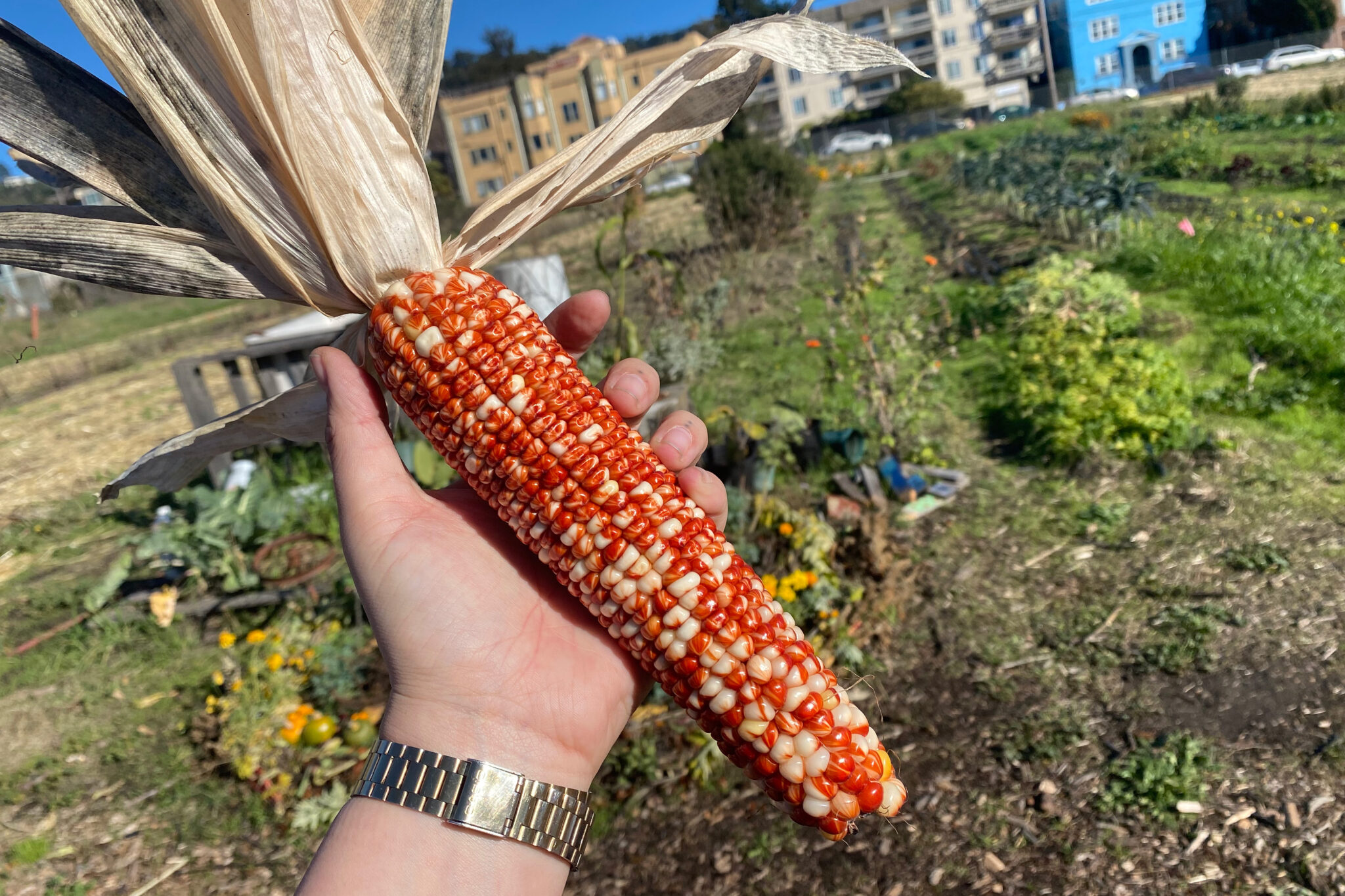
In the summer of 2023, members of Berkeley Student Farms grew several rows of heirloom corn on the Oxford Tract research field’s one-acre plot, with guidance from ab banks, BFI’s Agroecology and Wellness Coordinator. Students wanted to explore the entire process — from seed to table — of traditional foods made from masa, or dough, that has served as staple in Mesoamerican and South American cuisine since long before colonial times.
Processing maíz to make masa is an ancient practice that dates back thousands of years and remains a common practice in much of the world. Masa can be used to make tortillas, tamales, gorditas, sopes, pupusas, arepas, and atoles, to name a few. In December, once the Oxford Tract corn was harvested and ready to process, we decided to make pupusas, a thick, stuffed savory cake Salvadorians blessed the world with as their national dish.
There are plenty of amazing videos, books, and articles (take a look at the food systems library on the UC Berkeley campus!) that could have informed our process of making masa. But we wanted to tap into local Latinx communities around the Bay Area to guide us through this process and educate us about the ancient practice of processing maíz. This is how we came to connect with our colleagues, Morena and Guillermo, at Indigenous Permaculture, a network of urban farms and community members throughout San Francisco’s Mission District, Treasure Island, and East Oakland that gives away all its produce to low-income families. In December, we invited Morena to lead us in a masa making workshop.
Growing the corn took months, the harvest a few days, and the processing and cooking a few collective hours on a weekend. Our workshop participants, along with our BFI staff, had the immense privilege to connect with traditions and lifeways that have been practiced for thousands of years despite colonization’s violent but unsuccessful attempts to stamp them out. This workshop is the Berkeley Food Institute’s attempt to document this process.
From Seed to Harvest
Members of Berkeley Student Farms planted the maíz seeds in early 2023. Traditionally, maíz has also been planted with squash and beans, known as ‘tres hermanas’ or ‘milpa,’ which is a millenia old farming practice in which the maíz services as the structure to allow the beans weave their way up the maíz stocks, the beans contribute nitrogen to the soil, and the squash leaves provide shade to allow for ample soil moisture.
During BSF open hours, students would water and hand weed the crop as it grew to its full stalk size of about eight feet. Attendees of our Community Showcase at the Oxford Tract in September enjoyed walking through the rows during the field tour.
By late November, the maíz was mature enough to harvest. ab banks and several student volunteers were able to successfully harvest about 70 to 80 pounds of maíz still on its cob. Maíz, if stored properly in a cool and dry place, has a great shelf life. The drier it is, the easier it is to remove the seeds from the cobs or mazorca.

In 2023, Berkeley Student Farms, with guidance from BFI’s ab banks, grew an estimated 70-80 pounds of maiz.
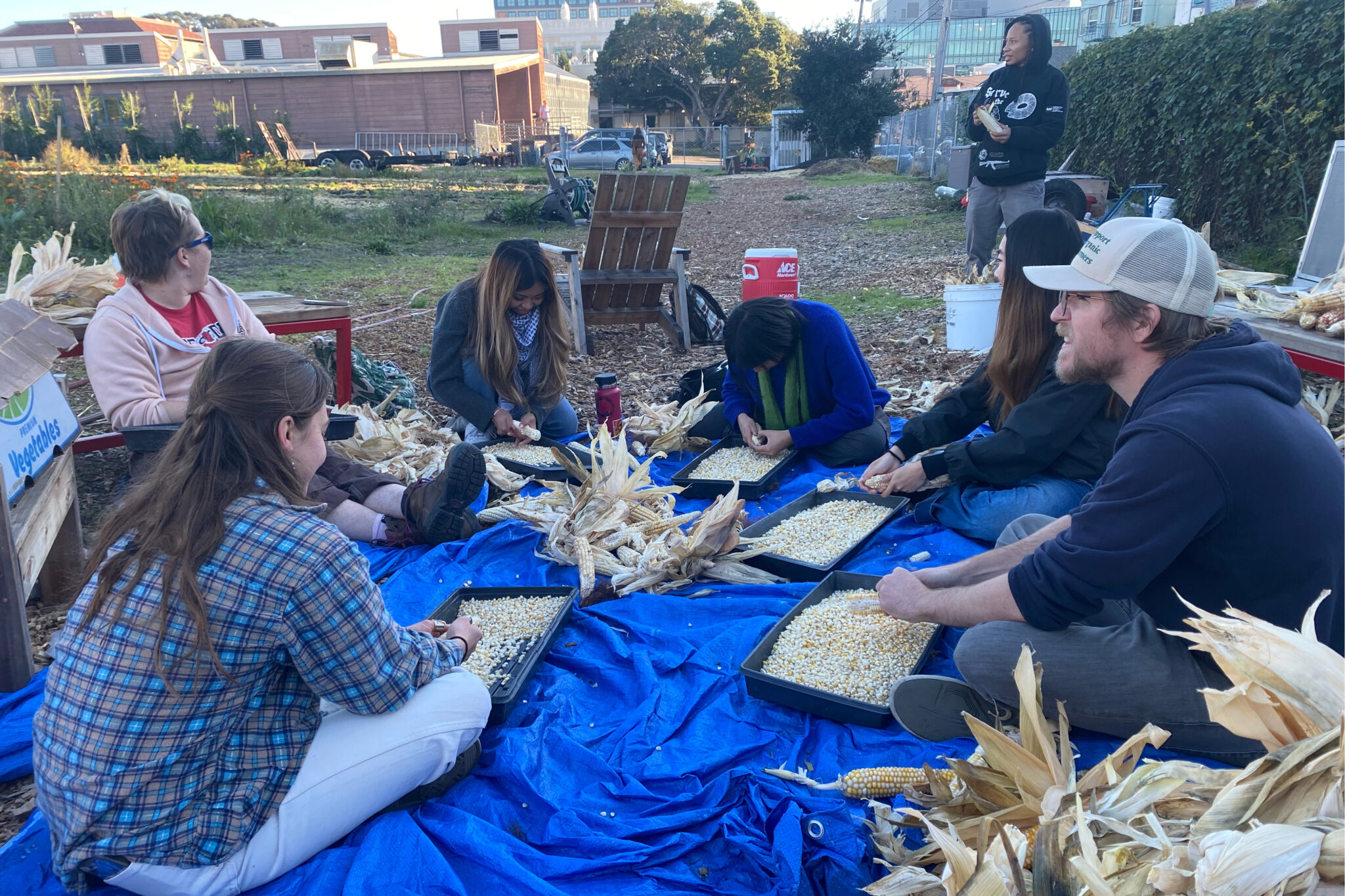
Berkeley Student Farms volunteers, including BFI Communications Coordinator Austin Price, de-grain the kernals to prepare to make masa.
Making Masa
De-graining took place on a crisp Friday afternoon in early December on the Oxford Tract, where ab laid out tarps to catch rogue seeds that would fly off as the students picked them from the cobs. As we were later taught by Morena, you can either hold the maíz length wise using both hands and use your thumbs to pick off the seeds one by one following the natural rows along the cob, or depending on how dry it is, simply grip the maíz with both hands and twist in opposite directions so that the seeds can instantly fall off. Since the harvest was a mix of well dried to semi-dry maíz, this humbling step in the process took several hours with each student volunteer gradually forming little mountains of de-grained cobs by their sides. Our hands were tender from twisting and picking off several stubborn seeds.
On day two of the workshop, ab and I went to San Francisco’s Mission District early Saturday morning to meet Morena and her friend Domingo to help us finish up the process back in the East Bay. We also made a pit stop at Indigenous Permaculture’s regularly scheduled produce distribution on Treasure Island to pick up a metate from our colleague, Guillermo. Metates are an essential tool for preparing masa that also enriches foods with vital minerals (akin to using a cast iron skillet to increase one’s iron intake). Before loading the heavy metate into the car, Morena quickly gave us a brief demo of how metates are traditionally used by setting it on the ground and squatting down to push the long rolling pin looking pestle, called a metlapil, back and forth along the flatbed of the metate.
We began the workshop in West Oakland at a volunteer’s house where we set up an open fire to begin boiling the maíz with cal. Cal, also known as calcium hydroxide or dehydrated lime, is a white powder that is an essential ingredient for cooking the raw maíz, adding flavor and aiding in nixtamalization, an ancient process that allows the nutrients of the maíz to become bioavailable. It’s also relatively inexpensive and can be found in your local Latino food store.
While we waited for the maíz to cook, Domingo shared about his Quechua heritage, his life back in Guatemala where he farmed and raised animals on a small plot of land that’s still in his family, and his journey to the US where he now works in construction, though he hopes to begin farming here in the US someday. Our waiting time for the maíz to fully cook was punctuated by Morena dipping a ladle into the boiling stock pot to pick out a single grain and pinch it open between her index fingers to see the grain slowly lose its chalky white texture. Once the maíz had been cooked through, it swelled up to almost spill over the sides of the stock pot and the cal turned the water yellow. Then the wash process began. We rinsed the maíz until the yellow tint from the water had completely disappeared, using our hands to churn through each colander.
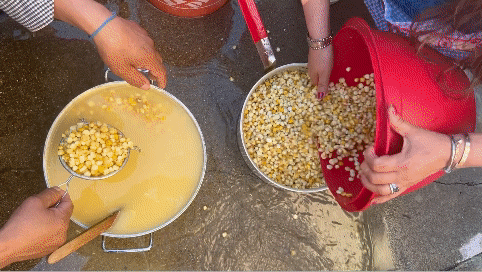
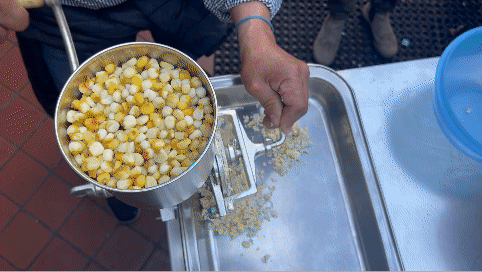
Once we washed everything, we packed up and headed over to the Cloyne Court Hotel, one of the Berkeley Student Cooperative’s (BSC) largest student housing units across the street from the Berkeley campus. Upon our arrival, we were greeted by more Berkeley Student Farms members and other curious Cloyne residents who joined the rest of our workshop as a break from studying for their final exams. Cloyne Court Hotel was fitted with commercial grade kitchens to feed their 120 student members. ab and I are BSC alumni, so walking through the painted murals in the long corridors filled us with nostalgia as we made our way to the massive kitchen area. Morena had also put on a long traditional Salvadoran skirt to get us in the spirit of cooking this beloved Salvi dish.
To make the masa, several enthusiastic students along with our staff took turns using a hand crank to grind the maíz. This was the most humbling part of the process — there’s nothing like grinding your own maíz that helps you develop a special reverence for the people in the world who still commit to making their masa this way.
We then mixed the ground maíz with water, and kneaded the dough on the metate, the final stage of the process before preparing the pupusas. Before that, however, Morena seasoned the metate by grinding in dry rice with the metlapil. This process is performed several times to remove bigger pieces of volcanic rock. Once enough batches of rice are ground through the metate without changing color, the metate is ready to use. Morena then worked the wetted masa on the metate to create a smooth dough ready to form into pupusas. The sound of the stone grinding the maíz into its final form was soft, steady, and familiar.
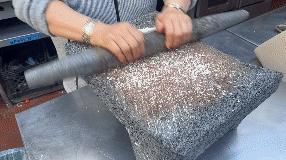
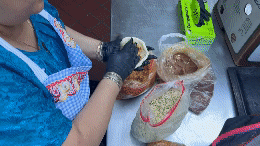
To make a pupusa, Morena showed us that you take a baseball-sized ball of masa and begin patting it back and forth between your hands to flatten it. Then, once it’s a little bigger than the palm of your hand, you cup your hand and add whatever filling you like. Morena pulled out three separate bags full of monterey jack cheese and loroco, chorizo, and refried beans. When she’d stuff the pupusas with all three fillings, that style is called revuelto. Once enough filling was added, she’d slowly pinch the top and begin softly patting the pupusa between her hands to reform its flattened shape. Carefully, she’d lay the pupusas down on the griddle to cook them.
Students and staff alike took turns handling the metate, filling their own pupusas and flipping them on the griddle. The kitchen began to crowd with hungry students as the delicious aromas of the masa, chorizo, beans, and cheese filled the hallways. It also helped that we had salsa, bachata, and cumbia music playing in the background to welcome them into their kitchen. The students lined up with their plates in hand, ready to indulge in this impromptu display of culinary tradition. Morena also brought along curtido — pickled cabbage and carrots — and several mild to spicy salsas to top the pupusas.
Reflection
For centuries, practicing these kinds of food ways with heirloom or wild maíz were made systematically difficult to access through violent settler-colonial seizure of Indigenous lands, US policies like the federal commodity program, and more modern economic treaties like NAFTA, which essentially flooded Mexico’s markets with US grown GMO corn and left small Mexican farmers and rural communities in ruin. So, weeks prior to this event, when ab reached out to the rest of BFI’s staff to see who would be interested in organizing and implementing the workshop, I felt called by my ancestors to make it happen and piped up.
While I was excited to help organize, I almost felt ashamed as a Mexican that I didn’t even know where to begin. At the same time, I recognize that the deliberate erasure of Indigenous life and foodways has led to many Mexican-Americans like me depending on the local Latino foods store to buy pre-cooked corn flour or masa harina. You can make decent tortillas with store bought masa, especially if you buy organic and high-quality masa harina. But masa as a result of access to land, freshly harvested corn, the right kind of processing supplies, and community sourced knowledge is unmatched.
Reaching out to Guillermo and Morena felt like reaching out to extended family. Guillermo was quick to connect me with Morena, one of Indigenous Permaculture’s volunteers, who has been living in San Francisco for decades and has been cooking Salvadoran cuisine since she was a child in her grandmother’s kitchen in El Salvador. She felt like one of my tias leading this workshop, making us coffee while we waited for the corn to cook in the cal, sharing pictures of her kids and her pets, sharing herbal remedies and recipes, and getting the students and staff to try each batch of pupusas as they came off the stove. It also helped that we were playing music throughout both days, something Guillermo urged us to do throughout the entire process from seeding to harvesting to processing to cooking to eating. Playing music can be as essential as the food in connecting us to our ancestors and these lifeways.
I welcome you, reader, to reflect on your own ancestral foodways. How do you connect with that? Who would you talk to in your family or in your community to tap into that? How can you share it or document it if it’s not something that’s as easily shareable. We are excited to host more workshops like this and shine a bright light on the phenomenal yet humble communities that are relentless in their efforts to preserve their foodways.